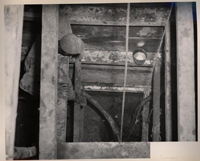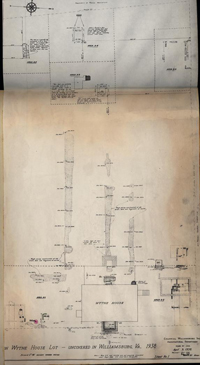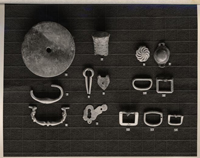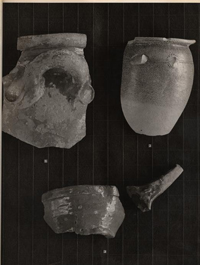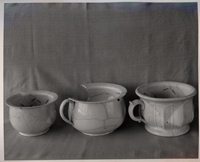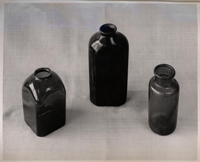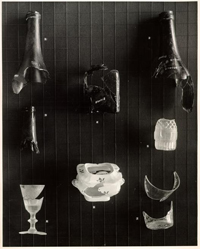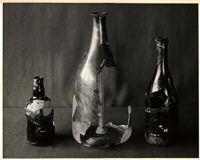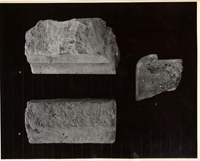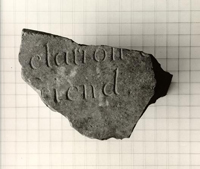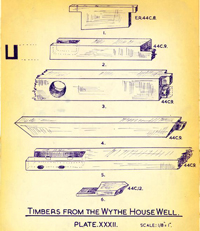George Wythe House Archaeological Report, Block 21 Building 4Originally entitled: "The Wythe House Site 21A Archaeological Report"
Colonial Williamsburg Foundation Library Research Report Series - 1487
Colonial Williamsburg Foundation Library
Williamsburg, Virginia
1990
THE WYTHE HOUSE SITE 21A
ARCHAEOLOGICAL REPORTAppendix to Archaeological Excavation Report of 1938.
CONTENTS
| Page | |
| Table of illustrations | |
| Preface | 1 |
| Survey of archaeological artifacts recovered during the excavations of 1938 | 2 - 35 |
| Introduction | 2 |
| Part I | |
| Area 21A1 | 3 - 4 |
| Area 21A2 | 5 - 9 |
| Area 21A3 | 10 - 17 |
| Area 21-A4 | 18 - 20 |
| Area 21A5 | 21 - 28 |
| Area 21A6 | 29 |
| Part II | |
| Excavation of the South Well and Dairy foundation, May - June, 1958. Summary | 30 - 34 |
| Survey of artifacts from the South Well | 35 - 56 |
| Ceramics | 37 - 41 |
| Glass | 41 - 50 |
| Small Finds | 50 |
| Stone | 54 |
| Wood | 53, 55 - 56 |
TABLE OF ILLUSTRATIONS
| Frontispiece - Wythe House South Well in course of excavation | |
| Archaeological plan of site 21A | following p. 2 |
| PLATE I Glass from vicinity of South Outbuilding | 3 |
| II Small finds of brass and copper | 4 |
| III Iron items from vicinity of North Kitchen | 7 |
| IV Examples of Creamware, Chinese porcelain, saltglaze, Delft and slipwares | 11 |
| V Objects of iron, copper, pewter and bone | 15 |
| VI Lug-handled stone mortar | 16 |
| VII Wig-curlers, marbles and counterfeit halfpenny of George III | 17 |
| VIII Examples of polychrome and monochrome decorated Chinese porcelain | 18 |
| IX Examples of coarse wares and brown stoneware | 20 |
| X German stonewares and English Delft | 21 |
| XI English saltglaze, scratch-blue and creamware | 23 |
| XII Glass beverage bottles of the period c.1740-60 | 27 |
| XIII Iron shears, pewter spoon and iron equestrian items | 28 |
| XIV Diagrammatic section through South Well | 31 |
| XV White earthenware chamber-pots | 37 |
| XVI Chinese export, ironstone and other ceramics | 38 |
| XVII Native, white earthenwares and American stonewares | 39 |
| XVIII Coarse wares, Chinese Export and white earthenwares | 40 |
| XIX Pharmaceutical glass | 41 |
| XX Ceramic ointment pots and miscellaneous glass | 44 |
| XXI Chemical and table glass | 45 |
| XXII Snuff, blacking or pharmaceutical bottles | 47 |
| PLATE XXIIIGlass beverage and storage bottles | following p. 48 |
| XXIV Bottles various & glass and ceramic tablewares | 49 |
| XXV Glass beverage and chemical bottles | |
| XXVI Small finds of bone, pipe-clay, brass and iron | 51 |
| XXVII Objects of iron from the well's lower levels | 52 |
| XXVIII Base of wooden paint tub and inscribed wooden fragment | 53 |
| XXIX Items of brick and worked stone | |
| XXX Fragment of inscribed gravestone | 54 |
| XXXI Shaped timbers, possibly from the well-head | 55 |
| XXXII Measured drawings of well timbers | 56 |
PREFACE
The Wythe property was excavated in seven major subdivisions, namely areas, A-1, A-2, and "Central Area" which encompassed the two lots occupied during the Wythe ownership and areas A-3, A-4, A-5, and A-6, which are on the lot to the west of the two Wythe lots and became a part of the property after the Wythe ownership. (See the report by Mary Goodwin dated February 1958, THE GEORGE WYTHE HOUSE ITS FURNITURE AND FURNISHINGS for a full discussion of the property ownerships and occupancies.)
The artifacts recovered from the excavation of the South Well in 1958 are included in this report and are presented in the same detail as finds dating from earlier periods because it is important to identify material which post-dates as we" as that which pre-dates the period of restoration.
18th June. 1958
I. N. H.
PART I
PART I
A SURVEY OF ARCHAEOLOGICAL ARTIFACTS RECOVERED DURING THE EXCAVATION OF THE WYTHE HOUSE PROPERTY IN 1938
INTRODUCTION
These notes deal almost entirely with artifacts in the Laboratory collection and are intended to serve as a supplement to the archaeological report dated August 31, 1939. Details of the excavations relating only to structural features are covered in the earlier report and are here omitted unless they have some bearing on the artifacts. When making use of this survey it should be remembered that all the items are unstratified and consequently can neither date the structures with which they may be associated nor by virtue of their archaeological provenance provide dating for each other. Consequently the given dates are based, not on their archaeological context, but on parallels from elsewhere, dated collectors' items, or more frequently by unsupported opinions. Many items which are clearly of post 18th century date have been omitted as also have pieces too fragmentary to be safely identified or to be of significance to the curator and architects.
It will be noticed that the described pieces were recovered from areas now the garden and outbuilding sites and not from the Wythe House itself. Some of the "finds" appear to have been recovered from cellars or pits which may have been used as disposal areas for refuse. Such pits contain rubbish from various parts of the property and consequently the artifacts do not necessarily bear any relationship to each other beyond the fact that they were thrown into the same feature.
1st November. 1957
I. N. H.
PART I
AREA 21A1
This heading covers three features, an outbuilding tentatively described as an early kitchen and with less certainty an office, a dairy mentioned in an insurance plat of 1815, and a well which was excavated to a depth of 9 ft. in 1938 and yielded up nothing that was considered datable. This well was 4' in diameter, seemingly unlined and undated, but was used in evidence in the identification of the supposed kitchen and dairy.1
There is no differentiation between artifacts from any of these three features. It can, therefore only be said that the finds cover a period stretching from c.1730 to well into the 19th century.
Ceramics
- 1.Frags. 2 chamber-pots, one Delft, one creamware. Colonial.
- 2.Frags. 1 dish and two Delft plates. 1st and 2nd ¼ 18th century.
- 3.Frag. brown stoneware indeterminate shape. Colonial.
- 4.Part of slipware plate, red ware, straight and wavy rings in yellow and brown over brown background, lead glazed red ware. New England. e. 19th century.
- 5.Porcelain largely 19th century. Also part of a large dish with floral pattern on wall and center, footring, rim and basal edge pale brown; part of small bowl with floral pattern on ext., brown rim hatched pattern on int. of lip. Both 2nd ½ 18th century.
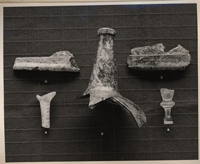 Plate I. Glass from Vicinity of South Outbuilding
Plate I. Glass from Vicinity of South Outbuilding
Glass
- 6.Two wine glass stems, these being the best pieces of glass from the entire site (a) a drinking-glass with solid-based bowl, solid stem supporting heavy, annulated knop, this roughly tooled up to the bowl base, a small ball knop at base of stem. Pl. I. No. 5. 2nd ¼ 18th century. (b) Opaque lace-twist stem with single outlining thread. c. 1750-80. Pl. I. No. 4.
It might be construed that the Delft and drinking glass (a) come from an earlier deposit than the rest of the material from this group. But there is no indication of any such division in the archaeological records of the area.
- 7.Rim fragments of green glass bell jar. Colonial. Pl. 1. Nos. 1-2.
- 8.Wine bottle fragments (not plentiful) c. 1750 - 1780.
- 9.Neck of large beverage bottle, probably gallon cap. c. 1740. Pl. I. No. 3.
Small Finds
- 10.Circular, brass, strap retaining loop, back missing, Catherine wheel decoration, diameter 1-¼". 18th century. Pl. II. No. 8.
- 11.Bridle boss from bit terminal, plain brass, width: 1-3/8". 18th century, Pl. II. No. 9.
Hardware
- 12.Part of iron grill, possibly drain grating, width: 7-½". Date?
AREA 21A2
This heading covers the area of the present kitchen, the chimney of which stood in a ruined state at the time of restoration. There is some evidence (see archaeological report dated 1939) suggesting that this kitchen dated prior to 1776.
Finds from this area range in date from c.1720 to the nineteenth century.
Ceramics
- 1.Fragment of Delft plate, foliate pattern in line and wash. C.1720.
- 2.Rim of small drug jar, cobalt banded decoration on shoulder, 1st 3rd eighteenth century.
- 3.Fragments 2 chamber pots of typical Westerwald type, and neck sherd with unusual decoration, bands of incised grooves flanked by broad single grooves cobalt filled, incised body decoration with cobalt filling, pattern uncertain. 2nd ¼ eighteenth century.
- 4.A number of brown stoneware fragments including pieces from two folded-rimmed, medium-sized storage jars (c.1730 onwards), also other eighteenth century pieces of indeterminate shape, and some nineteenth century fragments with internal Albany slip.
- 5.A few fragments of Green and Blue-edged wares, bias 10 to 2 in favor of the latter. Plates and serving-dishes, mostly late.
- 6.Creamware plate, no decoration, raised base but without footring, diameter 9-½". End of eighteenth century. Also fragment of late serving-dish.
- 6.
- 7.Few fragments English salt glaze; one sherd basket and hatched rimmed plate; ointment pot, and fragment cobalt decorated chamber-pot in Westerwald style. c. 1740 - 1760.
- 8.Coarse wares, mostly nineteenth century. Part of wide mouthed storage vessel, brown lead glaze (i.e. glaze over pink body), rim thickened and slightly everted, undercut beneath, ornamental groove 1" below rim. A shape which changes little from the late seventeenth century to the e. nineteenth century. Colonial.
- 9.Porcelain, largely nineteenth century. Fragment plate, base raised but no footring; base of small cup with black overglaze decoration; Ginger Jar sherds of uncertain date.
- 10.Ironstone plate marked "Mason's Patent Ironstone China. Imported by T. T. Kissam, 145 Maiden Lane New York." Date range 1813-1851.
Glass
- 11. Solid and heavy baluster from glass of uncertain type. e. eighteenth century.
- 12.Base of small tumbler, diameter 1-5/16", rough pontil mark at base. Colonial.
- 13.Elaborate decanter stopper, ground 1-¼", 2" collar above, tubular top, surviving ht: 1-7/8" and spreading, cap missing. Late eighteenth century.
- 14.Bowl and stem fragment, from a late Georgian wine glass, bucket bowl, tooling at junction of stem and bowl, angular knop at mid stem.
Small Finds
- 1.Part of wooden bat with flat blade and shaped handle. Length: 7. 9-¼", surviving. Blade width 2-3/8". Worm eaten, probably not found in the soil. Date?
- 2.Table knife, blade largely missing, handle bone plated, decorated with spine of fine hatching, with coarse hatching at either side, two iron rivets, short solid shank. Handle length: 3". 2nd half of 18th century.
- 3.Half pair of iron scissors, vertical loop, surviving length approximately 5-½" 18th century.
- 4.Pair of narrow-blade scissors, finger loops centrally set with decorative cordoning beneath, one loop broken. Length: 6-½". 18th century. Pl. III. No. 7.
- 5.Fragment of currycomb with crudely tapering handle looped on itself for hanging (?) Length of handle (total) 4-¼". 18th century. Pl. III. No. 5.
- 6.Fragment from cheekpiece of bit with brass rivet and remains of brass decorative boss (?) Length of fragment: 1-½". Pl. III. No. 8.
- 7.Iron hasp possibly from a gate or heavy chest, angled at the top to follow line of the post or lid, rolled grip below the eye. Total length: 7-½". Probably 18th century. Pl. III. No. 6.
- 8.Heavy gate hanger, straight-sided shank, but round sectioned pivot. Length 6-¾". Possibly 18th century. Pl. III. No. 4.
- 9.Round-sectioned iron rod with an angular hook at one end and a slot for a retaining bar or peg at the other. Possibly from the axle of a waggon. Length: 10-½". Date? Pl. III. No. 3.
- 10.Large iron pod auger, rectangular sectioned, shaft tapering and shaped to fit jaw of brace. Possibly 18th century. Length: 13". III. No. 2.
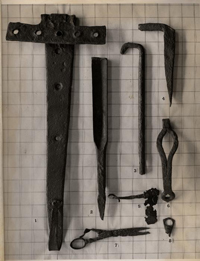 Plate III. Iron Items from Vicinity of North Kitchen.
Plate III. Iron Items from Vicinity of North Kitchen.
- 8.
- 11.Massive iron strap hinge bent back on itself at tapering end after use. 5 screw-holes on strap with a single nail hole on the remains of the decorative terminal. The jamb section possesses 5 screw or nail holes (the edges not recessed) and measures 7-5/8" in height. Surviving length of strap 23-½". Probably 18th century. Pl. III. No. 1.
- 12.Two buttons, one plain brass, brass shank, diameter ¾", marked DOUBLE GILT, probably late 18th century; the other a sporting button with greyhound and vine border on brass shell, brass back inscribed TREBLE STANDARD.........RICH Diameter 1-¼". Early 19th century.
- 13.Pewter spoons comprising handle of late Georgian example with remains of mark reading "Best Britannia Metal" surviving length 5-1/8"; another with spatula-shaped terminal with a raised spine both back and front concealing an iron core, and marked BRITA W, bowl missing, surviving length 3-1/2", early 19th century; the bowl of a large teaspoon 2" in length, e. 19th century; the handle of a tablespoon with moulded foliate decoration on both faces and mark "L.B." on one of them, lower end of handle melted and revealing iron wire core, bowl missing, surviving length 5", 19th century.
- 14.Iron pintle for supporting crane. This object is without a number, but it can reasonably be assumed that this is the item sketched on the archaeological drawing for Area 21-A, dated April 9, 1938, and which was found in situ in the west wall of the south fireplace. The tapering square-section bar, passed through the thickness of the fireplace, had a vertical pivotal bearing on the internal end and two retaining lugs or wings at the other. Length: 19-¾". The mortar still attached to one of the 9. lugs is of sandy character and of uncertain date. Mention is made in the archaeological report (1939) of "fireplace hardware in the south fireplace of the kitchen chimney," indicating that more than one item was recovered. An elevation shown on the archaeological drawing indicates the presence of a hook and of another pintle extending through the north wall of the south fireplace for use in the northern fireplace. Neither of these items are mentioned in the report of 1939 and there is no evidence that they ever came into the archaeological collection from the Wythe House property.
- 15.Two toy marbles, one white clay Pl. VII. 19, the other of ivory with a small hole at one side Pl. VII. 20. The latter could perhaps have been a knob from a lid and not a marble as here stated.
AREA 2lA3
This heading embraces two separate features and is consequently misleading in that it cannot offer any association of date or purpose among the artifacts recovered.
The premier feature is described in the archaeological report as follows:
"A filled-in pit was dug out to a depth near 4 feet (sic). Its length (east to west) was about 12 feet, its width about 8. There were no evidences of paving or lining. Short sections of filled trenches at grade level to south and west may mark the location of foundation walls, or may indicate nothing more than old trenches of unknown purpose.
Brick steps were found leading into the pit from the northwest. This entrance way had been bricked across near the bottom by an 8-½" brick wall.
This pit may have been used as a storage cellar under an outhouse of unknown function. Brick: Size varies. Well brick in steps. Mortar: Shell."
The description of the secondary feature reads as follows:
"A fill in the same area was excavated to show a trench about 10 feet square on the outside, and nearly two feet wide and deep. Meat bones, glass brickbats, and mortar were taken out, but there was no continuous brickwork. It is possible that this trench contained a foundation which was later salvaged, or that it was dug for a building which was never erected."
The date range on the artifacts from the combined features may be set at c.1720 to late nineteenth century.
Ceramics:
- 1.Delft, fragment late cylindrical drug pot with thick everted rim, white chamber pot sherd, pieces of plain bowl with foot 11. ring and everted rim in close stool style height 3-¼", c. 1730-60.
- 2.Fragment Delft bowl with cockled edge, stylized leaf pattern in blue on interior, double blue lines at junction of rim and wall, with festoons of blue along rim. Alternate (?) festoons overglazed in green with quadruple bars of red between each. Overglase green on some leaves on body. Lambeth? c.1720.
- 3.Slipware; Fragment of bulbous posset cup, Staffordshire combed ware. c.1730, base of red ware bowl, yellow inside (glaze over white slip) rich brown ext., - similar to examples from the Public Gaol, base diameter 2-7/8", late 18th century, e. 19th century? Base of small cup of buff ware, white slip coating with stripes of red over it, glaze turning red deep brown and white grey. Burnt after firing? Base diameter: 1-5/8".
- 4.Blue and Green edged wares; bias towards green, fragments 9 plates, dishes, and serving plates to 2 blue-edged plates. All good quality sherds green.
- 5.Scratch-blue; rim fragment of chamber pot in Westerwald style; body sherd from small tankard- 3rd ¼ 18th century. Pl. IV. No.
- 6.Creamware, plates in decadent "Queen's" shape, i.e. petal edge without moulded divisions extending from rim., tankards and mugs 4" diameter to approximately 2-7/8"; also cups, and bowls with angular footrings and with plain and rolled rims. A teapot spout with acanthus leaf decoration at base Pl. IV. No. 2; and a tureen lid handle, concave, constricted below a bead ornamented rim. Other sherds came from plain pitchers both large and small. The "Queen's" style plates, though varying in quality, may have formed part of a set. Diameters range approximately 8" to 9-¼". The majority of this creamware is late in its period.
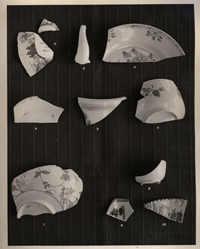 Plate IV. Examples of Creamware, Chinese Porcelain, Saltglaze, Delft and Slipware.
Plate IV. Examples of Creamware, Chinese Porcelain, Saltglaze, Delft and Slipware.
- 12.
- 7.Late creamware bowl with flattened rim and angular foot, height 4-1/8" foot, diameter: 5-1/16", mouth diameter 10-¾", c.1780-90.
- 8.Two underglaze transfer-printed creamware fragments from a single pitcher bearing the legend AGRICU[LTURE] C[OMMERCE AND] FRE[EDOM] of the SEAS, the medallion surrounded by scenes depicting the topics mentioned. Leeds or Liverpool c.1790-1810, Pl. IV. No. 1.
- 9.Coarse wares; probably all nineteenth century. Fragments red ware small bowls and chamber pot, black glazed, possibly western Virginia, e. nineteenth century. Part of red ware bowl, rich brown glaze flecked with manganese, rim folded and slightly everted, e. 19th century.
- 10.Red ware pipkin, brown glazed, foot roughly pressed out, probably to create three standing points, rim folded and drawn out into lip. 3-½" handle luted to and springing from rim opposite lip. Diameter approximately 5-½". The type appears in England in the latter part of the 15th century and continues without interruption into the 1st ½ 19th century. Pl. IX. No. 3.
- 11.Porcelain; largely 19th century, fragments of plate with blue floral pattern in center and on rim, hatched band at edge, base raised but no footring, pale brown on base and rim edges. Diameter: 9-¼". 2nd ½ 18th century, Pl. IV- No. 3. Small bowl with floral motif in red and blue, base diameter: 1-5/8". 3rd ¼ 18th century? Bowl with angular footring, individual floral- sprigs on exterior wall, no edge decoration on exterior, but line on interior below rim, barley type 13. festoons below terminating in occasional floral groups. Base diameter: 2-¾". Late 18th century, Pl. IV. No. 5. Straightwalled saucer, base raised, pale brown on basal edge, red overglaze festooning and dot decoration below single red line under interior rim. Occasional floral sprigs in base. Base diameter: approximately 3". c-1780, Pl. iv. No. 4. The porcelain displays a predominance of willow pattern which could not have been manufactured prior to 1792. (See Far Eastern Ceramic Bulletin, Vol. VIII. No. 1, March 1956. p.2.) This area also yielded a number of sherds of hand painted Staffordshire ware, both monochrome blue and polychrome, much of it of good quality. In this group may be included fragments of a Staffordshire white earthenware bowl in "spatter" style, decorated with vertical panels of sponged manganese divided by stripes of copper green. Most of this material may be dated c.1800-1825.
Glass:
- 12.A small quantity of beverage bottle fragments ranging from c.1740 to mid 19th century. The number of pieces from this area in the collection are so few that it seems strange that they should have been mentioned in the archaeological report (See p. 9). Many excavations elsewhere in the city revealed huge quantities of such glass, but it failed to draw comment. It may perhaps be that for some reason unknown the glass from this area failed to reach the collection or was discarded or misnumbered.
- 13.Small decanter stopper, lead glass, ball knop at top with five large tears surrounding five small bubbles. Large pontil mark at base. 1st ½ 18th century.
Small Finds:
- 1.Brass head of cane or umbrella, repousse decoration in the form of oriental style foliage, flaring at top, but with plain cap. Ht.: 1-¾", Top diameter: 1-9/16". Late 18th century? Pl. II. No. 2.
- 2.Copper lid with hole in center for missing knob handle, short cylindrical collar, top diameter: 4-½", collar diameter: 4". Possibly lid from late drug jar. 2nd ½ 18th century. Pl. II. No. 1.
- 3.Brass Jew's harp with remains of iron tongue. Length 2-1/8". 18th century. Pl.II. No. 4.
- 4.Brass drop handle, central disc knop, balusters at either side and simple scroll ornament below hangers, the back plain and angular. Width of handle: 3". 2nd ½ 18th century, Pl. II. No. 6.
- 5.Part of brass drop handle bulbous at center. Width approximately 2-¾". Late 18th century Pl. II. No. 3.
- 6.Brass curtain ring, exterior diameter: 1-¼" Colonial?
- 7.Flat brass button with short iron shank. Late 18th century; two other small bone buttons.
- 8.Small, brass, heart-shaped padlock with iron mechanism, the face decorated with an incised foliate scroll pattern. Height: 1", width: 1". Late Colonial. A miniaturelock of similar construction was found in a context of 1760-70 at Rosewell. Pl. II. No. 5.
- 9.Brass harness buckle, rectangular with "V"-shaped groove on fore edge to take tang, and single, straight groove on sides of upper surface on line with cross-bar; remains of iron tang. Width: 1-7/16" Colonial. Illustrated Pl. II. No. 11
- 15.
- 10.Oval brass buckle round sectioned, length: 1-11/16ti , 18th century? Pl. II. No. 10.
- 11.A collection of cutlery items comprising the remains of two bone handled table knives, one with a solid bone handle, the other with rivetted plates Pl. V. No. 3, length of handles: 3-3/8" and 3" respectively; two double pronged forks with pistol grips, the most complete measuring 6-½" overall Pl. V, No. 5; two small straight bone handled forks, one solid, the other plated, length: 2-¾" and 2-½" handle lengths; two other forks without handles, longest 6-¾" Pl. V. No. 4; three further bone handles with no metal attached Pl. V. No. 6, the handle of one pewter spoon with spinal ridge towards top, surviving length 4-¾", Pl. V. No. 7 (top). All the foregoing are considered to date from the second half of the 18th century. Also two pewter teaspoons, one extremely fragmentary, surviving length: 3-5/8" Pl. VII. No. 8; the other intact, with "heart" decoration at end of handle, marked on the back with an "X" under a stylized crown Pl. V. No. 9. Other cutlery items include the bowl of a much worn brass spoon, Pl. V. No. 7; and the handle of a light weight tinned copper spoon of simple form, length to bowl: 5", which is thought to be of nineteenth century date. It may be noted that there is more cutlery from this area than from anywhere else on the site.
- 12.Rectangular bone Plate, length: 5-11/16") tapering from 15/16" to 7/16", polished on one side, rough on the other and grooved at the smaller end to take the tang of some attachment, holes for pins on either side of groove. Presumably part of the handle of a fan. Uncertain date, Pl. V. No. 10.
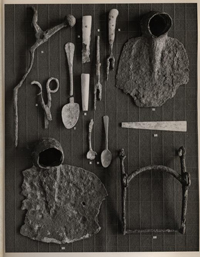 Plate V. Objects of Iron, Copper, Pewter and Bone.
Plate V. Objects of Iron, Copper, Pewter and Bone.
- 16.
- 13.Pieces of two pairs of iron scissors, one of them from a pair of sewing scissors with centrally attached loops, overall length: 4-5/8", late 18th century? the other heavier and spectacle looped, 19th century? Also one pair of iron scissors, spectacle looped and of 19th century date. Pl. V. No. 2.
- 14.Fragments of cut-throat razor, bone plated handle, the plates decorated with three horizontal double grooves. Late 18th century?
- 15.Two incomplete iron keys, the larger 6-¾" length, probably 18th century.
- 16.Part of iron fire tongs, interlocking arms, ball terminal. 18th century. Pl. V. No. 1.
- 17.Two iron hoes, width approximately: 6-¼" and 11", triangular spine on upper surface of both. Probably colonial. Pl. V Nos. 11 and 12.
- 18.Part of heavy iron bridle, width 5-3/811. 19th century? Pl. V. No. 13
- 19.Part of heavy stone mortar with one of a pair of lug handles. Height: 8-7/8", flat bottom. Mortars of this type were in use from the 14th century to the 19th century with little to distinguish between them. Pl. VI.
- 20.Small iron padlock, greatest width 2-9/16", thought to be 19th century.
- 21.Five horse shoes, all thought to be 19th century.
Builders' Hardware
- 22.10" iron HL hinge, square ended, five screw holes, arm of L missing.
- 23.9-7/8" iron HL hinge, foliate terminals, arm of L. missing. 18th century.
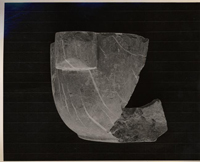 Plate VI. Lug-handled Stone Mortar.
Plate VI. Lug-handled Stone Mortar.
- 17.
- 24.Part of iron strap hinge constricted at end below spatula terminal. Surviving length: 1-¾". 18th century. Also another iron strap hinge, terminal missing, approximate length: 13". Another plain strap hinge, length: 14-½".
- 25.Three rim locks of uncertain date, but probably 19th century. If there is any inference to be drawn from this assemblage (and it is certainly dangerous to do so) it may be suggested that the 18th century cutlery could be indicative of domestic occupancy in the 2lA3 area in the 18th century. The broken ceramics are common to any domestic refuse pit or dump, but the presence of cutlery is, perhaps, less easy to explain.
- 26.A group of white pipe clay wig-curlers, comprising 14 examples, 4 incomplete. Pl. VII. No. 9, is stamped on either end with the initials IB under a crown. Mid 18th century. No. 10 is unusual, being of an orange and cream colored variegated clay. A similar example, Pl. VII. No. 15 comes from 21A4.
- 27.Two small toy marbles. Pl. VII. Nos. 21-22. Probably 18th century.
- 28.Counterfeit English halfpenny of George III, copper, date illegible. c.1770-1775. Pl. VII. No. 23.
NOTE: The archaeological drawing of this area provides the following significant information:
"This excavation contained mostly old bricks., bats and shell shell mortar. Several coins dated 1773 and a number of small 18th century objects were found."The dated coins, If stratified, would have provided important dating evidence for the group. However, no reference to these coins occurs in the archaeological report and no coins from feature 2lA3 are included in the Wythe House collection.
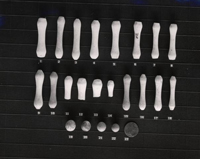 Plate VII. Wig-Curlers, Toy Marbles and a Counterfeit Halfpenny of George III.
Plate VII. Wig-Curlers, Toy Marbles and a Counterfeit Halfpenny of George III.
AREA 2lA4
This stage of the excavation may, perhaps, have cut through a reasonably tightly dated deposit, for there are fewer late intrusions than from any other area on the site. Furthermore, the archaeological record (1939) describes only one feature.
"A pit was opened up which was roughly similar in character and dimensions to that in Area A-3, except that there were no steps, nor any indication of foundations. The two pits are equidistant from the north property line, and separated from each other by about 35 feet."
Were it not for the presence of English white earthenware of the first quarter of the 19th century, the group of artifacts might have represented a valuable association.
Ceramics:
- 1.Delft, section through wide bowl in Chinese style, ornamented with floral scrolls in manganese. c.1740-60. Base diameter: 3-¼", Height: 3-3/16". This is the only piece of Delft from the area. Pl. IV. No. 7.
- 2.Slipwares: sherd of large Staffordshire combed ware dish, rouletted edge, c.1760. Base of large dish, yellow concentric rings on interior, 2nd ½ 18th century. Rim sherd of dish with rouletted edge, white slip combed away leaving orange body exposed, copper applied in patches over white. Western Virginia, e. 19th century or Staffordshire 2nd ½ 18th century Pl. IV. No. 10. Rim fragment of hemispherical bowl, orange body, white slip on interior splashed with copper and manganese Pl. IV. No. 9. The similarities in ware and coloring between these last two pieces suggests that they may be of the same date and origin. Further evidence is needed.
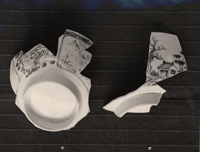 Plate VIII. Examples of Polychrome and Monochrome Decorated Chinese Porcelain.
Plate VIII. Examples of Polychrome and Monochrome Decorated Chinese Porcelain.
- 19.
- 3.German stonewares; fragments of two tankards, one with incised foliate decoration, also one chamber-pot sherd, all Westerwald and seemingly 2nd ¼ 18th century.
- 4.Brown stoneware; handle of jug or bottle, rich brown "Nottingham" color glaze. 2nd ½ 18th century. Probably from a vessel some 12" in height.
- 5.Porcelain; Fragments of two bowls, one polychrome, panels of garden motifs in blue and green., with red, gold, black overglaze red ju-i pattern on interior below brown-edged rim. Blue pomegranate design inside with red overglaze, angular footring, brown-edged. Base diameter: 3-¾" Pl. VIII. No. 1. A second bowl of approximately the same size, garden decoration on exterior in blue, elaborate floral motifs internally, hatched pattern on interior of rim Pl. VIII. No. 2. A basal fragment of a third bowl) of poor quality, blue floral decoration within,, and two sherds of plates were also recovered. Suggested dating for all c.1760-1800.
- 6.Green-edged ware; one sherd from plate, last ¼ 18th century.
- 7.Saltglaze; section through a small cup in Chinese style, footring and no handle, thin walled, no decorated base, diameter: 1-½", height: 1-5/811, Pi. IV. No. 8.; basal sherd from large tankard, slightly incurving at base of wall, bands of decorative grooves and ridges above, lead glazed externally; rim sherd of bowl, hatched scratch-blue decoration, no shape determined. Overall range c.1730-60.
- 8.Hand-painted white earthenware, "Staffordshire"; sherds of saucer, cup and bowl, all with poor quality Chinese decoration and dating from the 1st ¼ 19th century, thus barring the 20. area 2lA4 from being classed as a strictly colonial feature.
- 9.Coarse wares; rim, handle and body sherd from "bread bin," the rim rolled, a wide but shallow groove 3/8" below it, large horizontal handle, thumbed at either end (one of a pair), base missing, surviving height 7-½", pale brown glaze inside and out. Such vessels changed little throughout the 17th and 18th centuries. Pl. IX. No. 1.
Small Finds:
- 1.4 wig curlers, medium size, three white pipe clay but one, Pl. VII. No. 15, of orange and cream colored variegated clay, with small holes at either end. 18th century. See Pl. VII. No. 9. Nos. 16 and 18 are stamped W.B beneath a crown, at either end, a well known English mark of the 18th century.
AREA 2lA5
This area includes but one unit and yielded a large number of artifacts, many of which must have been in use contemporaneously. The archaeological field report reads as follows:
"A pit 6 feet deep and roughly 4 x 13 feet in plan was dug out near the southwest corner of the property, about 20 feet from the church wall. There was no archaeological evidence as to the purpose of this pit, but its 18th century date was attested by the character of the fragments recovered (china, iron items, etc.)"
However, no mention is made of the base of a large ironstone china basin bearing the mark STONE CHINA H.BURGESS.BURSLEM, a firm which war, not established in Burslem until 1851 which is in the collection from this feature.
When evaluating the significance of deposit 21A5 notice should be taken of the large number of equestrian items found therein.
Ceramics:
- 1.Fragments of 3 Delft drug jars, monochrome decorated, 2 banded (one section height: 3-5/8"), the 3rd with banded zones, dash pattern at top and bottom and chain motif around girth, Pl. X. No. 4. Overall dating c.1720-60.
- 2.Basal sherd of cylindrical cosmetic (?) Jar with monochrome floral decoration on wall. c.1750. Pl. X. No. 6.
- 3.Fragments 2 plain Delft drug pots. 18th century.
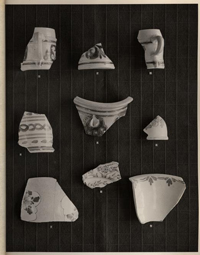 Plate X. Examples of German Stonewares and English Delft.
Plate X. Examples of German Stonewares and English Delft.
- 22.
- 4.Fragments. White Delft bowl with everted rim, mid 18th century; bases of two smaller bowls, base diameter: 2-3/8" and 2-7/16". These may have been decorated on the walls, but the absence of any pattern on the interior bases suggests that they were more likely to have been plain. Two further bases are decorated on the interior with floral motifs, One having a blue stiple on the exterior, base diameter: approximately 3-½", and the other marked with a cobalt V within the footring, an area of heavy blue on the wall suggests that the side was adorned with a pictorial motif rather than a simple floral pattern, base diameter: 2-5/8". The overall dating may be set c.1720-50.
- 5.Rim fragments. Two Delft bowls of small size, the 1st of good quality, thin-walled, and decorated with individual flowers, mid 18th century, and the 2nd of inferior quality, thick-walled and decorated with a flowing floral design, 2nd ¼ 18th century.
- 6.Wall fragment of Delft bowl decorated with floral medallions in cobalt and surrounded by an overall manganese stiple. 2nd ¼ 18th century. Pl. X. No. 7.
- 7.Fragment Delft bowl with everted rim, decorated on rim interior with blue pendants linked by festoons in red and green overglaze, the red rough-surfaced. Bristol c-1720-30. Pl. X. No. 9.
- 8.Section through Delft plate, leaf and floral pattern on rim and center, leaves in characteristic angular brush strokes and flowers formed by dots within touching arcs. An almost identical plate comes from the site of the Virginia Gazette printing office (18H). See Garner's English Delftware Pl. 36b. Lambeth c.1700-1720. Pl. X. No. 8.
- 9.Fragments two Delft plates., both with stylized floral motifs, one possibly Dutch. 1st ½ 18th century.
- 10Fragments 5 small Westerwald tankards, two with foliate scroll decorated Pl. X. Nos. 1 and 2. and two with checker pattern Pl. X. No. 3, one of the latter 3-5/6" in height and one of the Former 3-½" in height. 2nd-3rd ¼ 18th century.
- 11.Rim sherd of Westerwald chamber-pot. 2nd ¼ century.
- 12.Fragment of Westerwald storage jar with thickened and slightly everted rim, two horizontal looped handles, 2 bands of cobalt below rim and groups of cobalt circles running together around at junction of handles to body. Probable diameter: 6-1/8". 2nd ¼ 18th century. Pl. X. No. 5.
- 13.Rim and body fragment of horizontal loop-handled jar, brown stoneware, rim everted, upper 4-¼" slipped and fired mottled brown, pink interior, double groove around exterior on line of handles, exterior diameter approximately: 6-¼", approximate height: 7". c. 1740-70. Pl. IX. No. 2.
- 14.Base of large, brown stoneware jar with pulling marks on the bottom, base diameter: 5-7/8"; also two body fragments from another jar. 18th century.
- 15.Rim fragments 3 white saltglaze plates, one with foliate scroll ornament, basket and open-weave panels, the latter with the addition of stars or dots in alternating panels. c.1750-60, Pl. XI. No. 5, the others smoother surfaced., retaining the open-weave panels, but the basketweave replaced by blank cartouches enclosed by fern scrolls. c.1760-70 Pl. XI. No. 4.
- 16.Small saltglaze cup, cylindrical type body on square cut footring. c.1750. Height: 1-9/16".
- 17.Fragments of three small saltglaze tankards, one with slightly spreading foot, the base raised within, diameter 2-5/8", surviving height: 3-5/16" Pl. XI. No. 2; the second a rim sherd with small handle grooved down the spine, brown slipped at the lip Pl. XI. No. 3. Both these fragments have a yellowish cast to the surface and a coarse pale brown body. 1st ¼ 18th century. The third fragment a body sherd from a small tankard of similar size to the others, the body thin and of good quality. c.1720-40.
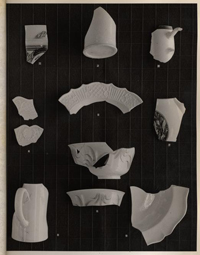 Plate XI. Examples of English Saltglaze, Scratch-Blue and Creamware.
Plate XI. Examples of English Saltglaze, Scratch-Blue and Creamware.
- 24.
- 18.Two basal fragments of a large white saltglaze vessel of uncertain shape and purpose, the body slightly incurving towards base, bottom raised within square cut ring and sagging in the center. Interior matt and without salting. Mid 18th century?
- 19.Fragments of "scratch-blue" bowl with flaring rim and small beaded foot, the base raised and flat within, the body thin and of good quality, decoration on exterior wall frond groups ups alternately erect and everted. Height: 2-7/8", diameter: 7", base diameter: approximately 2-¾", c.1740, Pl. XI. No. 6. A fragment of another bowl of similar size and date, but with a decoration of scratch blue swags and pendant radiating lines, was also recovered from 21A5.
- 20.Three "scratch blue" tankard fragments but with blue permitted to flow over field, lead glaze partial over surface; the largest a rim fragment of good ware, thin, a tooled cordon 1-1/8" below rim, slightly constricted above cordon and widening proportionately at lip, edge of Georgian medallion surviving on sherd. c.1740-60, Pl. XI. No. 1.
- 21.Two "scratch-blue" chamber-pot sherds, the color flowing onto field, a deep blackish blue. c.1740-60.
- 22.Base of "scratch blue," saucer, star decoration on interior, groups of small lines radiating from two compass drawn arcs, small footring, diameter: approximately 2-½". Mid eighteenth century.
- 23.Small creamware mug or tankard, plain handle surviving, glaze much crazed, base raised within angular foot, base diameter: 25. 3", height: 4-¾". 1770-1800, Pl. XI. No. 8.
- 24.Soup plate, creamware, petal edge of Queen's ware, but without moulded lines extending across rim, base slightly rising, height: 1-3/8", base diameter: approximately 6-¼", c. 1780, Pl. XI. No. 9.
- 25.Fragment of creamware plate and of chamber-pot, both of indeterminate form.
- 26.Two fragments of transfer-printed creamware, one a small cup with fine quality footing, diameter: 1-½", decorated in overglaze with a garden scene, pre revolutionary; the other part of a pitcher decorated with an underglaze medallion to left of spout showing a woman spinning. c.178o-1800, Pl. XI. No. 7
- 27.Two coarse ware sherds; base of black glazed bowl, red body, base diameter: 2-¼", western Virginia, e. 19th century? and rim sherd of large dish or cream pan, brown glaze, rim grooved internally and rolled outwards - identical to another example from 28F4 which may be dated c.1770-90.
- 28.Saucer base, hand painted white earthen ware, Staffordshire, pictorial scene on interior in Chinese style, small angular footring, incised circle in center of underside of base, the glaze collecting as a blue line within it, and also on the interior junction of footring and body. c.1800-1820.
- 29.Base of large basin, ironstone, bearing the mark " STONE CHINA H. BURGESS. BURSLEM." The firm of Burgess and Leigh, as mentioned earlier, was established in Burslem in 1851, and is still in operation today. The piece may be loosely attributed to the last 3rd of the 19th century.
Glass:
- 30.Eleven bottle bases and two necks of forms ranging from c.1740 to c.1790.
- 31.Beverage bottle, olive green metal, with short cylindrical body, domed kick, heavy string-rim extending to lip, tooled downwards and square cut beneath, height: 8", base diameter: 4-½", c.1750, PL. XII Center. See Beverage Bottles in Colonial Virginia, Figure 3, Nos. 19-22. This bottle had a hole in its side before being thrown away, but it was also unfortunately shattered in excavation. Traces of yellow sandy clay still attached to the bottom of the bottle are the same as those clinging to the pewter spoon (Small Finds No. 1.) indicating that both objects came from the same layer. Two more bottles were recovered from this deposit, both of the same date as the foregoing and both broken at the shoulder before being thrown away. Pl. XII. left and right.
- 32.Base of large bottle with shallow domed kick, the wall curving outwards above the base, suggesting a ball-shaped body of unusual form, metal olive green, base diameter: 5" wall extending to greatest surviving width of approximately 8". Other examples have been found on the site of the Levingston House (29A2) which was occupied by Dr. Gilmer after 1735. This bottle form should not be confused with the large sized squat bottles of the period 1710-25, for on these the wall does not protrude beyond the width of the base.
- 33.Disc terminal from poor quality decanter stopper, the edges chamfered, diameter 1", late 18th-19th century?
Small Finds:
- 1.Pewter spoon with spinal ridge down upper surface of handle and vestigial rat-tail on back of bowl, length 8-1/2". A common colonial form in Williamsburg. (See p. 26 Glass, No. 32) Pl. XIII. No. 7.
- 2.Part of iron fork, two pronged, and with flat tang with iron rivets to hold bone or wooden handle plates, no collar below handle. Late 18th century.
- 3.Brass drawer escutcheon (incomplete) key-hole for key with slightly curving bit, sides winged, face incised with rough scroll and foliate ornament, edges bevelled. Total width approximately: 3-½". Colonial. Pl. II. No. 7.
Hardware:
- 4.Face of andiron, flat cast in pillar form with simple cap, surviving height: 8-7/16". Colonial.
- 5.Simple arm of fire tongs looped at top and with oval grip pad, surviving length approximately: 18-¾". Probably colonial.
- 6.Blade and spring haft of pair of shears, no ornament at blade top, blade length: 5-¾", total length: 12-5/8 Colonial? Pl.XIII. No. 1.
- 7.Incomplete curry comb with solid horizontal plates and with cruciform reinforcement on back. Greatest width: 6-5/8". Colonial type. Pl. XIII. No. 3.
- 8.Two bit sections of linking bar form, but not a pair. 18th or 19th century. Pl. XIII No. 4.
- 9.Cheek piece of bit, of, double coned bar type, iron brass rivet for ornamental boss surviving, but boss absent. A colonial form. Pl. XIII. No. 2.
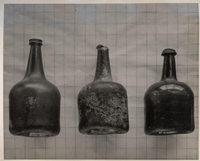 Plate XII. Glass Beverage Bottles of the Period c. 1740-60.
Plate XII. Glass Beverage Bottles of the Period c. 1740-60.
- 28.
- 10.Pony shoe, iron, upturned at the heels, but no toe cap, three holes per side. Width 4-¼ 18th century.
- 11.Stirrup, iron, rectangular leather loop, solid oval footplate. Height: 5-3/8". width: 5-¼ Colonial Pl. XIII. No. 5.
- 12.Stirrup, iron, oval, pivoting leather loop, gridle type footplate, two bars across open oval-, height: 7", width: 5-¼", round sectioned sides flattened 1-½" above footplate. Date uncertain. Pi. XIII. No. 6.
- 13.Wide socketed iron hoe, 2-3/8" interior diameter width of blade more than 6-½", broad rib on upper face., concave below. Sandy clay clinging to socket suggests an affinity with Glass No. 31 (p. 26). and Small Finds No. 1 (p. 27).
- 14.Two incomplete iron carriage (?) springs, length: 7-¼" and 11" respectively.
- 15.Arm of large iron strap hinge with disc terminal, length: 23-¾". Traces of sandy clay attached to rust. (See No. 13 above). Also a smaller arm, length 11-1/6 another 9-¾" in length, both of uncertain date.
- 16.Remains of wood encased iron lock with plate slightly flaring at rear end, length 7-¾". 18th or 19th century.
- 17.Heavy lock bolt, length 9", sandy clay on surface (See No. 13 above).
- 18.Iron door or gate hanger, rectangular sectioned spike, now twisted, and round sectioned pin, the latter slightly set back allowing the fore edge of the spike to protrude beyond it, total height: 3-¾ Sandy clay attached (see No. 13, above).
- 19.Iron handle of large skillet, hollow hafted for wooden handle, attached to bowl by copper rivets through heart-shaped flange, haft length: 10". Possibly 18th century.
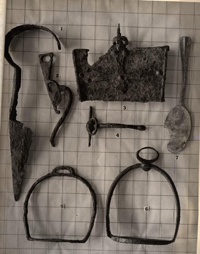 Plate XIII. Iron Shears, Pewter Spoon and Iron Equestrian items.
Plate XIII. Iron Shears, Pewter Spoon and Iron Equestrian items.
AREA 2lA6
The above area covers the north end of colonial lot #241 and embraces a fragmentary brick foundation thought in 1938 to be the stable building recorded on the insurance plat of 1815. The archaeological field report (1939) mentions the discovery of "several large brass harness buckles."
The archaeological notes in the report read as follows:
"The west wall is 30-40 feet from the present west property line (wall and line not parallel). The north wall is 4-½ feet from the north line. The foundation is 20 feet 5 inches wide. No trace of the east wall could be found, but the length of the extant north wall showed that the building was more than 27 feet long. There was no trace of floor or other paving. Bricks: 8-¾ x 4 x 2-¾, color: Reddish buff. Bond: English. Mortar: Shell."
Few artifacts recovered from 2lA6 but their relationship to the building is not known.
Small Finds:
- 1.Three small brass harness buckles, breadth: 1-9/16", 1-¼", and 1-9/16" (Pl. II. 12, 14 and 13) the last being rectangular while the others are rounded on their fore edges. These are the only buckles from 2lA6 which appear to be located in the archaeological collections. The description of the buckles given in the quoted archaeological report hardly seems to fit these small objects and it is possible that the ones referred to have been lost. (It is noted that the collection now contains more horse furniture from 2lA5 than from 21A6. 18th-l9th century).
Hardware:
- 2.HL hinge, iron, incomplete, and with horizontal of the "L" missing, approximate height: 10-½", much decayed and date uncertain.
- 3.Fragment of cast iron, part of stove or ornamental grate (?) crescent form with scroll and foliate ornament in classic style.
PART II
PART II
EXCAVATION OF WYTHE HOUSE SOUTH WELL AND DAIRY FOUNDATION
May-June 1958
Summary
As part of the research project to determine the original use of the Wythe House south outbuilding, it was suggested that the excavation of the associated well might reveal evidence of the building's purpose. The suggestion was approved and the excavation was carried out during the months of May and June, 1958.
The top of the well had previously been excavated during the full archaeological investigation of the site in 1938 and was reported on in the subsequent report (p. 8) as follows:
"A filled-in well 4 feet in diameter, between the South Outbuilding and the Dairy, was opened up to a depth of 9 feet. No evidences of a lining were discovered, nor any indication of the date of the well.* Its location offers some support to the assumption that the nearby remains may be those of a kitchen and a dairy."
The results of the 1958 excavations throw some new light on the foregoing statements. It is now considered unlikely that the well and the south outbuilding were in use contemporaneously, no evidence that the well was dug prior to c.1800. However, it is likely that the well and dairy were of the same date, i.e. c.1800-1815.
31.The salient factors supporting these premises are as follows:
The South Well
At 13' below the present grade the top of the brick lining was encountered, the upper courses having been removed for re-use, probably during the decade 1860-70. A fill of mixed clay, dirt and trash extended from 8'6" 1 to 18' representing a deposit inserted after the upper well bricks had been robbed. The inclusion of two pieces of printers' type in this fill suggested that it had been brought from the site of the Printing Office (18H).
At 18' the sealing deposit gave way to an accumulation of refuse thrown into the well during the last days of its existence. This wet, organic stratum descended to a depth of 28' below modern grade and contained a large quantity of refuse deposited no earlier than 1853. The presence in the layer of medicine bottles, flasks and items of chemical glassware indicated that the artifacts came from the Wythe House during the occupancy of Professor John Millington who rented it in 1835, bought it in 1841 and sold it in 1866. It should be added that Millington was, for a time, Professor of Chemistry and Natural Sciences at the College of William and Mary and that in 1848 he had gone to the University of Mississippi in a similar capacity. Evidence of this move is indicated by the presence in the well of a small lead glazed pot of non-European manufacture, probably a souvenir brought back from the Professor's southern travels. It seems probable that the refuse may have been thrown into the well in 1866 when Millington sold the Wythe House.
At 28' four large timbers were found wedged in the shaft and it was these which had prevented the upper filling from sinking to the bottom.
 Diagrammatic section through South Well
32.
When these timbers were removed the remainder of the filling which they supported sank into ten feet of water. It has been deduced that the timbers -possibly part of a simple well-head - collapsed into the well and floated on the surface of the water. Subsequently, Millington's trash was thrown down, some of it sinking past the timbers, but the majority piling up on them until a platform or false-bottom was established. Evidence of this is derived from the discovery of fragments of the same ceramic vessels, both above the platform and at the bottom of the well.
Diagrammatic section through South Well
32.
When these timbers were removed the remainder of the filling which they supported sank into ten feet of water. It has been deduced that the timbers -possibly part of a simple well-head - collapsed into the well and floated on the surface of the water. Subsequently, Millington's trash was thrown down, some of it sinking past the timbers, but the majority piling up on them until a platform or false-bottom was established. Evidence of this is derived from the discovery of fragments of the same ceramic vessels, both above the platform and at the bottom of the well.
After a long delay caused by an inability to pump out the water, work was resumed and the remains of the collapsed upper layer was extracted. Beneath this, at approximately 38', was found a quantity of refuse which had fallen past the timbers when first thrown in. The finds included ox skulls, chemical glasswares and pieces of mid 19th century ceramics. A small number of coarse sherds, possibly dating from the 18th century, were also recovered, but as they overlay 19th century material they cannot be used in evidence.
The bottom of the brickwork was reached at 39'7", under which was found a well-preserved wooden form, 3" in thickness,1 resting on natural blue marl.
The absence of any primary deposit of 18th century artifacts at the bottom of the well could indicate firstly, that the well had remained completely clean until it was abandoned, secondly, that it had been totally cleaned out during the course of its life or thirdly, that the well was of 19th century date. The first theory may be dismissed as highly improbable, but the second demands careful consideration. However, the realization that the water still flows into the well too fast for it to be emptied without the 33. aid of mechanical pumps and that the shaft is too deep even for these to function properly, indicates that it would have been virtually impossible for 18th century well cleaners to have extracted anything but large items which would have been reached by a grapple. Small artifacts and the natural accumulation of organic silt could not have been extracted by this means. Providing that this "fact" can be accepted, there remains only the third explanation.1
The diameter of the well at the top surviving course was approximately 4' 7-½", but tapered to 3' 4" at the bottom. A number of well bricks were found in the fill above the timber platform, many of them with shell mortar attached. However, none of the bricks found in situ had been mortared, indicating that the upper courses only had been mortared and that in prying them loose, some had fallen into the well. One of the well bricks was retained and measures 8' x 4-3/8 x 3-¼" x 3", 37 of them making up the circumference of the well.
The South Dairy
The re-excavation of the S.W. corner of this foundation revealed a single course, 1 brick in thickness, unmortared. It was found that a lone well brick had been incorporated in this foundation, the brick, measuring 8" x 4-7/16" - 3-¼" x 3". The similarity of measurement and texture between this brick and the specimen from the well could indicate that they came from the same source. Furthermore, the absence of mortar on the well brick could suggest that it was left over after the digging of the well and that it was thereupon incorporated into the foundation of the dairy. If this were so, then it would automatically follow that the well must have been completed prior to 1815 when the dairy first appeared on an insurance plat. The dairy's absence from the plats of 1801 and 1806 indicates (though does not 34. prove) that it was not in existence prior to 1806 and 1815.
The archaeological data recovered from the re-excavation of the dairy did not provide any conclusive dating, although some general pointers were provided.
- (1)It was found that the bed of marl previously recorded as being confined within the walls of the dairy actually extended beneath the foundation and beyond it both west and south. It might be suggested, therefore, that the foundation rested on the remains of an earlier marl path or yard. Artifacts found beneath the marl proved that it could not have been laid before the decade c.1770-80, and consequently, the dairy must date to the same time as the laying of the marl or, if the marl served some other purpose, to another date between c.1780 and 1815.
- (2)A hole was discovered, dug into dirty clay beneath the 1" marl strat[a] suggested that it had been cut to house the roots of a plant, thus pointing to the existence of a garden at this point prior to 1780. Finds from the fill of the hole indicated that it had been dug during the third quarter of the 18th century.
- (3)While no evidence for the destruction date of the dairy was found, a deposit of burnt clay and wood ash overlay the marl within the building. Such a deposit appears out of place in a building devoted to cooling rather than heating. It is, therefore, Just possible that this building (which does not appear in exactly the position shown on the insurance plat) may not have been the dairy, but a structure in which heat was used, built after 1815. If this were so, there would be no reason why the date of the well might not also be brought forward.
Survey of Artifacts from the South Well
The difficulties encountered during the excavation of the above well made it impossible to determine the exact position of each artifact. However, the fact that the contents of the shaft could be divided into three distinct strata, each of them a unit unto itself, made it necessary to record only that the finds came from layers I, II, or III. These divisions were as follows:
- 8' 6" - 18', a fill of mixed clay, ashes and trash deposited after the upper courses of the well's lining had been robbed, some of it possibly brought from 18H,, the site of the Printing Office. (Originally extending to surface.)
- 18' - 28', a filling of domestic trash and organic materials thrown into the well after it had ceased to serve its intended purpose. Post 1853 and probably dating c.1866. This stratum rested on and around a group of fallen timbers wedged in the well which supported the whole over a water-filled void which extended downward to a depth of 38' (below modern grade.)
- 36' - 39'-10", representing 2' of refuse which collapsed from stratum II, and the primary filling which was proved to be of the same date as the above level (see P. 32). The layer terminated below the lining of well and rested on blue marl.
Artifacts recovered from the well were numbered by bags, each containing material recovered from a point lower than the last. It was found that the contents of each bag represented the finds from approximately 1' of fill. All artifacts from the well excavation bear the Excavation Register number 44. Material from the filling deposited after the well bricks had been robbed is labelled E.R.44A and E.R.44B (A = 8'6" -11"6" and B = 11'6" - 18'). Artifacts found below 18' are marked E.R. 44C1-14, the latter numbers indicating bag and level in progression down the shaft. Finds from the three strata of the well are accordingly identified as follows: 36.
| Layer | Excavation Register Number |
|---|---|
| I | E.R. 44A and E.R. 44B |
| II | E.R. 44C1 to E.R. 44C9 |
| III | E.R. 44C10 to E.R. 44C14 |
All the principal items from the well are illustrated in the following plates and described below. However, there were also innumerable fragments of glass and pottery which did not merit photography; these have been retained but have been omitted from this report. Significant among the omissions were the skulls of two oxen, one calf and a horn from a second young ox, all of which were found at the bottom of the well (E.R.44C14). From E.R.44C8 came a fragment from the plastron of a turtle (possibly a snapper). A facial fragment of a human skull comprising maxilla, two molars and part of the nasal cavity, was recovered from E.R.44C1. Also of note were five semicircular coping bricks from E.R.44C2-5, only one of which was retained. This measures 11-3/8" x 5-½" x 3" and is pale orange in color.
37.PLATE XV
Left. Small white "Staffordshire" chamber-pot with flat and everted rim, small, angular footring, the base raised within, the glaze slightly blue in the crevices, handle missing, but with thumbed pad surviving at its top junction with body. Height: 5-1/8 Diameter: 7-7/8". E.R.44C6-7. First half of 19th century.
Center. Large chamber-pot, details similar to the above, but with more shallow footring. Height: 5-¾", Diameter: 9-½". E.R.44C9. First half of 19th century.
Right. Large Ironstone chamber-pot with elaborately moulded body in the style of an acanthus leaf decorated capital. The handle follows in the same stylized foliate mod; the rim thick and slightly everted, the foot equally heavy and streading, the base slightly raised within the foot and bearing the mark "IRONSTONE" above "H & G late HARVEY," the complete legend capped by the English royal arms and supporters. This mark is an important piece of evidence in the dating of the well filling. The initials H & G stand for Holland & Green who took over the business of C & W Harvey of Longton in 1853. The new management specialized in the exporting of ironstone to North America until 1862 when they switched to South America. It may, therefore, be assumed that the chamber-pot dates between 1853 and 1862 with the bias towards the earlier date on the evidence of the reference to "late HARVEY"; it being reasonable to suppose that the new management would trade on the good name of the old firm only during the first years of its operation. Height: 5-7/8", Diameter: 9-1/8", E.R.44C5-7. c.1853-62.
PLATE XVI
- 1.Rim sherd of Canton, Chinese export plate, debased willow-pattern decoration, blue wash on rim and pattern in same color. Base slightly raised within the foot, the latter unglazed. This fragment was later united to others from the same plate which were found towards the bottom of the well. (See Plate XVIII, No. 5) E.R.44C9. First half of 19th century.
- 2.Rim sherd of deep saucer transfer printed in blue. E.R.44C9. Probably mid 19th century.
- 3.Porcelaneous saucer with moulded decoration in festooned dots and baskets with botryoid and foliate devices highlighted in purplish blue, the base raised within a small foot. E.R.44C5-7. c.1740-60.
- 4.White earthenware plate with hand-painted floral decoration in purple, green, red, brown and pale blue, the base raised within a small footring. Mark on the base reading 3953, almost certainly applied by the painter. E.R.44Cl-2. Second half of 19th century.
- 5.Ironstone plate (inverted), upper face somewhat dished creating quarter-round moulding on exterior above the small footring. The mark a leopard to left over the inscription GRANITE CHINA above T & J MAYER Longport. The partnership of T. & J. Mayer as depicted by this mark would appear to date between c-1836 and c.1851. E.R.44C7-9. Second quarter of 19th century.
PLATE XVII
- Small Mexican or Indian pot, thin, lightly-fired red ware with thin lead glaze on the upper body, bulbous body tapering to small flat base, pronounced cylindrical neck flaring at the rim. Height: 3-3/8". Rim diameter: 2-13/16". Probably brought or sent home after Professor Millington took up his post at the University of Mississippi in 1848. E.R.44C4. Date uncertain, but probably 19th century.
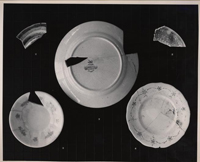 Plate XVI. Chinese Export, Ironstone & Other Ceramics
Plate XVI. Chinese Export, Ironstone & Other Ceramics
- 39.
- Cylindrical porcelaneous mug with light sprigged handle, the base slightly raised. Gilded decoration in a band below the rim and above the foot, with traces surviving of a gilded inscription reading "Remember Me". 3-¼" height; Diameter: 3-1/8 E.R.44C9. Third quarter of 19th century.
- Condiment pot in white earthenware, mould-made, and copying silver form, flaring collar below the rim, carinated body and small spreading foot, moulded lug handles, hand-painted decoration, purple flowers with green stalks and leaves. Basal fragments only from E.R.44C9, the upper fragments were later recovered from E.R.44C10 & 13. (See Plate XXIV. No. 8 for scale.) A fragment from a small saucer of the same ware and decoration was also found in E.R.44C9. Second quarter of 19th century?
- Cylindrical mug of "Staffordshire" white earthenware, banded decoration on body in creamware tradition and with foliate terminals to the handle. The base spreading and the bottom markedly raised within. The glaze appearing bluish in the crevices. Height: 3-¼", Diameter: 3-½". E.R.44C9. First quarter of 19th century.
- Cylindrical preserves jar of "Staffordshire" white &cream earthenware, deeply grooved below the rim for tying down fabric or paper cover. The base very thin and raised within a square cut foot. Height: 3-¼", Diameter: 3-5/8". E.R.44C5. First Quarter of 19th century.
- Child's chamber pot in "Staffordshire" white earthenware, the rim flattened and everted, small slightly spreading footring, the base raised within, foliate terminals to handle in creamware tradition. The glaze smooth internally, bluish in crevices, but "salted" surface to the exterior. Height: 4-5/16", Diameter at rim: 6-½". E.R.44cg. First quarter of 19th century.
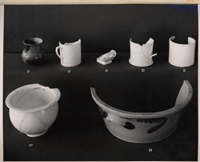 Plate XVII. Native, White Earthenware and American Stoneware ceramics.
Plate XVII. Native, White Earthenware and American Stoneware ceramics.
- 40.
- American grey stoneware pan decorated in cobalt, the rim thickened and flattened on the top, the base slightly spreading and the bottom slightly rising, undercut lug handles and groove around the body beneath it. Height: 5-7/8", Diameter at rim: 12-13/16". E.R.44C5-6. Mid 19th century.
PLATE XVIII
- 1.Rim sherd of lead-glazed pan, the rim thickened and rolled, tooled beneath. A broad groove internally below the rim; red body and greenish-brown glaze on the inside only. E.R.44C13. Probably 18th century.
- 2.Rim and body sherd of lead-glazed pan or wide bowl, the rim rolled and offset beyond a deep groove below the lip, possibly to house a lid. Orange red body, purple on the exterior, ginger-brown glaze internally. E.R.44C11. Probably second half of 18th century.
- 3.Fragmentary shell-edged plate with blue overglaze edge decoration, slightly rising base but no foot. E.R.44C13. c.1800.
- 4.Body and basal fragment of coarse Chinese export dish, blue underglaze decoration, heavy body unglazed on the base. E.R.44cl2. Late 18th to early 19th century.
- 5.Chinese export plate,Canton, with debased willow-pattern decoration, blue wash on rim and pattern in same color. Base slightly raised within the foot, the latter unglazed. E.R.44C11 & 13. (See also joining fragment from E.R.44C9. Pl. XVI. No. 1) First half of 19th century.
- 6.Rim fragment of scalloped edged plate, pale blue transfer-printed white earthenware. E.R.44C12. Probably second quarter of 19th century.
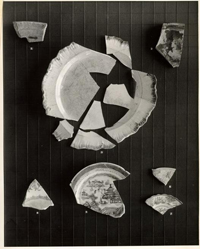 Plate XVIII. Coarse Wares, Chinese Export and White Earthenwares.
Plate XVIII. Coarse Wares, Chinese Export and White Earthenwares.
- 41.
- 7.Miniature plate fragment, scalloped edge and brown transfer-print. E.R.44C11. First half of 19th century.
PLATE XIX
- 1.Moulded bottle with the word LONDON in high relief on one face, the corners concave, the neck slightly flaring and the lip rolled inwards and tooled flat, the base slightly rising and with traces of a pontil-mark. The metal a pale bluegreen. E.R.44C3. Probably second quarter of the 19th century.
- 2.Small, moulded, lead glass bottle copying the well-known 18th century shape associated with Turlington's Balsam. (See example illustrated in the Virginia Gazette Archaeological Report. Vo. III. The Wythe example is longer in the neck and more angular in the body and the poorly moulded lettering is almost illegible. The legend on the illustrated face reads: ROBT TURLINGTON FOR HIS INVENTED BALSAM OF LIFE, on the left side: Jan.26. 1754 (?), on the right: LONDON, and on the back: BY THE KINGS ROYAL PATENT GRANTED TO. The rim is everted and tooled slightly downward and there is a diagonal mould-mark across the base. Clear, thick metal E.R.44C1. Late 18th or early 19th century.
- 3.Small, moulded, soda glass bottle in the style of the 18th century Turlington's Balsam bottles, the neck taller and with only a small everted rim, diagonal mould mark as well as pontil-mark on the base; pale blue-green soda metal at the base becoming almost clear when thin. The legend on the illustrated face reads: M KINGS PATENT, no inscription on either side, the back reading: TURLINGTONS BALSLM (sic). It may be noted that the spelling of balsam on the 18H bottle reads BALSOM. E.R.44cl. Early 19th century.
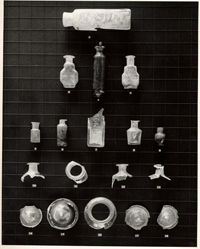 Plate XIX. Pharmaceutical Glass.
Plate XIX. Pharmaceutical Glass.
- 42.
- 4.Cylindrical phial, the rim everted and down-tooled, the base domed internally and with pontil-mark on the exterior, clear metal. This phial still retains its cork through which runs a brass wire with what appears to be a brush or swab on the other end. The phial contains a small quantity of a yellowish liquid, apparently part of the original contents. E.R.44C1. Late 18th to early 19th century.
- 5.Small mould-made phial with straight neck and small, everted rim, the base slightly raised within a ring. A moulded inscription on the body reading: HARRIS PHILADA. E.R.44C0. Probably second to third quarter of 19th century.
- 6.Small cylindrical phial with short neck and flattened and everted rim, small conical basal kick and remains of pontil mark on the bottom. Similar to but smaller than No. 4. E.R.44C3. Late 18th or early 19th century.
- 7.Base of square-bodied, mould-made bottle, the base thick and slightly rising, exhibiting pontil-mark and crossed, impressed mould-marks. The moulded inscription on the illustrated side reads M]AGRESIA, on the left: ..C]HESTER, on the right: CAL]CINED, and on the back: ... RYS. E.R.44C4. Late 18th or early 19th century.
- 8.Small phial manufactured in a two-piece mould, thick, and slightly flat base with pontil-mark, the body broader at the shoulder than at the base, cylindrical neck and roughly flattened and everted rim, clear metal. E.R.44C3. Probably second quarter of 19th century.
- 9.Miniature phial, crudely made, with large pontil-mark on the base and with the bottom thick and uneven, tubular neck without lip; green metal similar in color to the common phials of the 18th century. Cork still inside. E.R.44Cl. Early 19th century?
- 43.
- 10.Neck of large cylindrical phial, weak-shouldered, the rim roughly flattened and everted, the metal thin and pale blue. E.R.44C3. Early 19th century.
- 11.Neck of wide mouthed phial, short cylindrical neck, weak shoulder and everted and down-tooled rim, thin, clear metal. E.R.44C4. Early 19th century.
- 12.Neck of cylindrical phial, thick, flattened and everted rim,, cylindrical neck on angular shoulder, clear metal. E.R.44C4. Early 19th century.
- 13.Neck of cylindrical phial similar to but smaller than No. 10. E.R.44C4. Early 19th century.
- 14.Domed base of medium-sized phial, irregular, pontil-mark, the body slightly spreading at the base; metal pale blue. Possibly the base for No. 13. E.R.44C4. Early 19th century.
- 15.Base of large phial or jar, the base domed beneath with large pontilmark, the dome extending to a nipple internally, the cylindrical body slightly spreading at the bottom. Clear metal. Remains of dried contents still attached to interior. Possibly the base belonging to neck No. 15. E.R.44C2. Very late 18th or early 19th century.
- 16.Neck of small jar, the rim flattened and everted, the neck slightly constructed above the shoulder, the latter weakly sloping to an unevenly formed cylindrical body, clear metal. Probably belonging to base No. 15. E.R. 44C1&4. Very late 18th or early 19th century.
- 17.Base of medium-sized cylindrical phial, the base rising above a rough pontil-mark to a shallow cone, clear metal. E.R.44C3. Late 18th to early 19th century.
- 44.
- 18.Base of medium-sized cylindrical phial similar to No. 17, but the metal thicker and the body markedly constricted above the base. E.R.44C9. Late 18th or early 19th century.
PLATE XX
- 1.Base of cylindrical moulded bottle, ribbed and reticulated mouldmarks on the body, the base slightly domed with central nipple, the metal olive green. Probably for olive oil. E.R.44C1. Probably mid to third quarter of the 19th century.
- 2.Neck of eau de Cologne or salt bottle, the neck tubular and widening slightly at the mouth. No lip, deep green metal. E.R.44C5. Late 18th to first half of 19th century.
- 3.Neck and body fragments of flask of extremely thin, pale green metal, the body bulbous and the neck spreading to a mouth of uncertain form. Fragments of a similar vessel were found at Marot's Ordinary. Others in apparently the same form come from sites 4A and 28F4. the latter probably from the post 1770 deposit. These last examples are in a pale bluish green metal. Fragments of a vessel of identical color and form were found in a trash deposit at St. Olave's Church, Hart Street, London, where they were dated to the decade 1720-30. E.R.44C1-2.
- 4.Base of cylindrical bottle of uncertain type, slightly rising base with pontil-mark, pale blue-green metal. E.R.44C2. Probably second quarter of 19th century.
- 5.Base of cylindrical bottle of uncertain type, the body slightly widening towards the shoulder, base thick and shallow-domed with pontil-mark, metal pale blue-green. E.R.44C9. First half of 19th century.
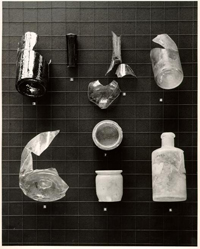 Plate XX. Ceramic Ointment Pots & Miscellaneous Glass.
Plate XX. Ceramic Ointment Pots & Miscellaneous Glass.
- 45.
- 6.Cylindrical bottle, mould-made, slightly domed base with pontilmark, a short, straight neck with the lip everted and down-tooled reinforced with an applied trail, pale blue-green metal. A moulded inscription on the body, lettered from shoulder to base, reads: ...& REEDS COMPOUND CHLORINE TOOTH WASH. E.R.44C1. First half of 19th century.
- 7.Small white earthenware ointment pot, a shallow ridge below the lid recess and a corresponding ridge at the base, the bottom raised and flat within a square-cut foot. An ante cocturam stamp thus: ¾, on the bottom. E.R.44C4. Probably third quarter of the 19th century.
- 8.Small earthenware ointment pot, everted rim constricted below for tying down fabric or paper cover, the body slightly incurving at the base and the bottom gently rising with a rough screw of clay attached. Pale grey body with a thin yellowish glaze inside and out. No parallels have been found for this item; but it may be suggested that it is derived from the Delft ointment pots of the 17th and 18th centuries, although the shape is closer to the former than to the latter. It is considered unlikely that a coarse, handmade pot of this type would have been made later than the first quarter of the 19th century. E.R.44C3.
PLATE XXI
- 1.Body and basal fragments of two tumblers of the same type, moulded, hexagonal with the circular rim slightly offset above the straight sides, the base flat and raised within a broad ring. E.R.44C7-8. Mid 19th century.
- 2.Foot of heavy wine-glass, hand-made, thick slightly rising foot ground in the center, the stem resting on a pad and commencing with a wide angular knop, E.R.44C6. Probably mid to third quarter of 19th century.
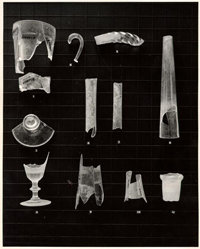 Plate XXI. Chemical and Table Glass.
Plate XXI. Chemical and Table Glass.
- 46.
- 3.Wine glass, three piece, the base thick, flat and slightly rising, ground in the center, the stem spreading into a flattened knop at junction with the foot, a bladed knop at the mid point, and the top having a spreading knop and collar giving an annulated appearance, the bowl thick based, funnel-shaped and decorated with 12 cut facets topped by a deep groove with a band of multiple, vertical grooving above. E.R.44C9. A rim fragment was later recovered from E.R.44C11 and the reunited pieces appear as Pl. XXIV. No. 6. First quarter of 19th century.
- 4.Small lead glass handle, hand-made and folded on itself at the tail. Probably from a jelly glass. E.R.44C7. Late 18th to early 19th century.
- 5.Fragment of decorative stalk, lead metal, wrythen ground with single air twist thread in the center, one end roughly square ground to be inserted into a metal or glass support. The item comes either from a table chandelier or from a sweetmeat epergne. For examples of each see G. B. Hughes' English, Scottish & Irish Table Glass Pl. 269 and 235 respectively. E.R.44C3. Early 19th century.
- 6.Fragment of glass tube, probably from the neck of an item of chemical. glass. E.R.44C0. 19th century.
- 7.Fragment of glass tube, similar to, though thinner than the above. E.R.44co. 19th century.
- 8.Conical glass tube, thickening at the tapered end, carefully though not professionally cut from a larger object at the other. Presumably an item of chemical glass. E.R.44C1. 19th century.
- 9.Body fragments from an unidentified tapering glass object, possibly from the same item as one of the tubes. Nos. 6 & 7. E.R.44C8. 19th century.
- 10.Body fragments, smaller, but similar to the above. E.R.44CO. 19th century.
- 47.
- 11.Base of a specialized chemical funnel (?), comprising a body flaring outward above a slightly tapering tube ground on the outside and with a reinforcement at the junction. The tube is also ground on the inside and represents the converse of the shape exhibited by the exterior, i.e. the aperture being wider at the bottom than at the top. It is suggested that the funnel was made so that it could be fitted into a wide mouthed vessel or over that of a small bottle or tube. E.R.44C4. First half of 19th century?
PLATE XXII
Left. Square bodied bottle,. the corners flattened., diminutive everted rim, the latter springing from a curving shoulder, the base flat and pitted with the marks of a clay (?) mould and with pontil-mark, the metal amber-green and much bubbled, American made. Height: 4-3/16", width at base: 2-3/8" E.R.44C8. First decades of 19th century.
Center. Octagonal moulded bottle, broad faces at back and front, three smaller at either end, curving shoulder tapering upwards to a slightly everted mouth, the base gently rising and with a tubular pontil-mark. The metal amber and much bubbled, American made; probably for snuff or blacking. Height: 6-¼", greatest width: 2-¾". E.R.44C1. First decades of the 19th century.
Right. Wide mouthed bottle, free-blown, cylindrical body incurving at the base, the latter gently domed and with an oval tubular pontil-mark, the shoulder angular and the neck tubular everted and down-tooled at the top to provide the rim. The metal deep green and bubbled. Probably of American manufacture. Height: 4-¾". Diameter: 2". E.R.44C9. First decades of the 19th century.
PLATE XXIII
Left. Beverage bottle, moulded, the neck slightly constricted at junction with the shoulder, the string-rim an angular collar below a thickened lip. The base conical. The metal amber-green with some bubbles. Height: 8-½", base diameter: 2-5/6". This bottle may be compared with examples from the site of the Raleigh Tavern which burned in December 1859. E.R.44C0 & 3.
Center. A large cylindrical storage bottle, the body moulded and reticulated on the surface, the base thick and gently domed. The shoulder rounded and rising to a short., slightly tapering neck topped by a thick marvered trail forming a heavy and uneven rim. The metal is an olive green and remarkable for its extreme thinness in the body. Height: 12-½", base diameter: 5-3/8". E.R.44C9. Presumably first decades of the 19th century.
Right. Wine-bottle, a tall tubular neck slightly widening at the top with a trailed string-rim ¼" below the roughly cut mouth. Slightly twisted striations down the neck are typical of bottles of this type. A tall conical kick at the base; the metal olive green. French. Height: 1-1/8", Base diameter: 3-3/8". E.R.44C9-11. Additional fragments were subsequently recovered and these had been added when the bottle was rephotographed, Plate XXV. The remains of grey wax are still attached to the string rim. Mid 19th century.
PLATE XXIV
- 1.Neck of wine-bottle similar to that shown in Pl. XXIII right, differing in that the trailed string rim grips the neck more firmly than does that of the former. Olive green metal; French. E.R.44C11 Mid 19th century.
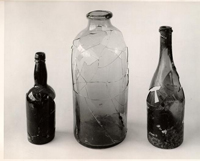 Plate XXIII. Glass Beverage and Storage Bottles.
Plate XXIII. Glass Beverage and Storage Bottles.
- 49.
- 2.Neck and body fragments of wine-bottle similar to the above, but the string-rim marvered against the neck to form a broad collar; and the metal a deeper green; French. E.R.44C13. Mid 19th century.
- 3.Neck of wine-bottle similar in style to Nos. 1 & 2, but the string-rim smaller and the metal amber and thus better preserved. French. E.R.44C11. Mid 19th century.
- 4.Square, moulded bottle with the corners flattened, the shoulder rounded and sloping up to a slightly everted mouth, the base rising to a shallow cone and with pontil-mark beneath. The metal extremely bubbled and bright amber in color. The shape and size are similar to those of the example shown in Pl. XXII, left. E.R.44C12-13. First decades of the 19th century.
- 5.Base and body of moulded condiment pot (?), the base gently domed and with pontil-mark and irregular rings beneath, multiple decoration of the body comprising pillar moulding with 12 rectangual facets above, the latter capped by a zone of embossed diamonds. Clear metal now cloudy. E.R.44C12. Second quarter of the 19th century.
- 6.The wine glass described in detail under Pl. XXI No. 3. E.R.44C9 &11. First quarter of the 19th century.
- 7.Base and rim fragments of a thin-walled tumbler, the body flaring towards the mouth, the base slightly rounded and rising to a shallow dome. Additional fragments of this glass were retrieved after the photograph had been taken thus reconstructing a glass 3-½" in height. E.R.44C12-13. First half of 19th century.
- 8.Condiment pot in white earthenware, hand-painted floral decoration. For details see under Pl. XVII, No. 3. E.R.44C9, 10 & 13. Second quarter of the 19th century.
PLATE XXV
Left Small beverage bottle, cylindrical body and short neck slightly tapering towards the string-rim, the latter created from an applied trail thickening the lip and down-tooled to create two overhanging ridges - a style copied by the moulded string-rims of the 19th century. The base rising in a conical kick, the metal a rich olive green and the body slightly pitted from contact with the mould. Height: 7-¼", base diameter: 2-7/8". E.R.44C11. c.1800.
Center Heavy, clear metalled bottle,, somewhat conical in the body and with slightly domed base. The neck rises to an everted mouth thickened by an applied trail. Were it not for this last feature the bottle's shape could be compared to that of a common decanter form of the mid 18th century. This bottle is probably an item of chemical glassware. Variations in color are caused by some of the fragments having been burnt after breaking. Height: 13-1/2", base diameter: 6". E.R.44C13. 19th century.
Right Wine-bottle as illustrated and described under Pl. XXIII, right, but with additional fragments added. E.R.44C9-11. Mid 19th century.
PLATE XXVI
- 1.Bone knife handle, rectangular-sectioned. E.R.44C3. This object split as it dried. 19th century.
- 2.Bone knife handle, rectangular-sectioned, small. E.R.44C2. 19th century.
- 3.Ribbed bone handle of uncertain purpose, threading for screw-cap or attachment at the broad end and recess for collar at the narrow; tubular with uniform bore. E.R.44C3.
- 51.
- 4.Bone toothbrush handle, flat-backed, but markedly humped at the front, spatula-ended and tapering to an extremely narrow waist at the junction of brush and handle. E.R.44C1.
- 5.Bone toothbrush handle, oval sectioned, the handle somewhat humped, spatula-ended and tapering to an extremely narrow waist at junction of brush and handle. E.R.44C1.
- 6.Bone toothbrush handle, flat with rounded end and tapering to junction of brush and handle. E.R.44C3.
- 7.Flat bone plate with rectangular groove at the narrow end, the broad end incomplete. Probably part of a fan. E.R.44C1.
- 8.Bone plate from knife or fork handle, pierced by three rivet holes. E.R.44C4. Probably first decades of the 19th century.
- 9.Bone plate, triangular sectioned, one side smoothed and the others showing saw cuts. Unknown purpose. E.R.44C4.
- 10.Bone plate similar to the above, but lighter in color and with longitudinal groove at one end and a notch at the center point of one side. Unknown purpose. E.R.44C2.
- 11.Rectangular bone brush back, somewhat arched, the handle extending from the brush without any waist or point of demarcation, four rows of bristle holes and four deep grooves to house the stitching at the back,, also one transverse groove close to the end. E.R.44C5. First half of 19th century?
- 12.Bowl and stem fragments of one or more clay tobacco-pipes, the bowl pillar-moulded and with vestigial spur, no maker's mark. This style developed from the pillar moulded forms of the last quarter of the 18th century. E.R.44C9. First half of 19th century.
- 13.Bowl fragment of clay tobacco-pipe from an S-shaped pipe which was attached to a stem and mouthpiece of a different material. E.R.44C0. No earlier than third quarter of the 19th century.
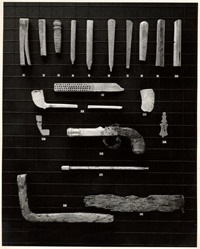 Plate XXVI. Small Finds of Bone, Pipe-clay, brass & Iron.
Plate XXVI. Small Finds of Bone, Pipe-clay, brass & Iron.
- 52.
- 14.Thin brass plate with two right-angled sides, two parallel and one curved between the latter. E.R.44C3.
- 15.Lady's muff pistol, percussion, brass barrel, iron hammer, mechanism and trigger guard, wooden handle, spreading outward at the butt, probably intentional but possibly resulting from warping in the well. A maker's mark on the left side of the barrel directly below the cap housing reads LEG within an oval. The barrel somewhat bulbous at the muzzle, cordoned and with a collar 1" from it, the barrel octagonal behind the aforesaid collar. E.R.44C9. Another rather smaller pistol of the same type was found on site 9K, this too bears a maker's mark within an oval at the same point as that on the Wythe pistol; however, the 9K mark reads IEG - it could, perhaps, be read as a lower case L. Mid 19th century.
- 16.Brass keyhole cover from padlock with swivel at the narrow end. The remains of a stamped inscription ".......TEL." E.R.44C3. Probably early 19th century.
- 17.Brass rod, round sectioned, but square cut below a collar and groove at one end and screwing into a sleeve at the other. The latter is hollow and threaded with a deep notch across the slightly beveled mouth. E.R.44C3. Of uncertain purpose and date.
- 18.Square sectioned, l-shaped iron bar of uncertain purpose. E.R.44C2.
- 19.Thin iron strip, right-angled at one end; of unknown purpose. E.R.44C2.
PLATE XXVII
- 1.Iron horseshoe, block heel terminals, probably no toecap, deeply grooved on the line of the nail-holes, four nail-holes at one side and three at the other, a fourth hole was started but never completed. E.R.44C12. possibly 18th century.
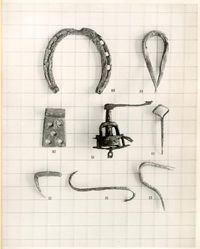 Plate XXVII. Objects of Iron from the Well's Lower Levels.
Plate XXVII. Objects of Iron from the Well's Lower Levels.
- 53.
- 2.Large iron staple round sectioned at the centre and sharply bladed at the ends. E.R.44C12. This item was found in the marl under the wooden form at the bottom of the well.
- 3.Half a small, hand-made, iron hinge with five countersunk screw-holes. E.R.44C13.
- 4.Handle and mechanism from a coffee or pepper mill, hand-made, iron wings extend from either side of the grinder, two bolts piercing it and screwing into a comparable plate below the mechanism. This last has a small, eyed screw or swivel in the center. The upper wings originally possessed an additional bolt-hole at either end for attaching the working parts to the wooden box. The handle terminates in a small hole which once served to attach a rotating knob. E.R.44C11. Early 19th century?
- 5.Small wrench-like iron object of uncertain purpose, diamond-shaped eye at one end, the shaft angled above it and tapering to a corroded point - incomplete. E.R.44C13.
- 6.Bent iron spike possibly a tine from a rake, or alternatively part of a staple. E.R.44C13.
- 7.Long S-shaped iron hook, possibly from a spit. E.R.44C12.
- 8.Mutilated iron staple, round sectioned at the centers, but bladed towards the ends, one end incomplete. E.R.44C13.
PLATE XVIII
- 1.Circular end from a small wooden paint tub. An inscription in red Paint reads SETUIUIL & BROTHER MANUFACTUME around the edge and PHILA across the center. Height of tub: 7-¾". E.R.44C9. See also p. 55.
- 2. Fragment of green-painted wood, possibly the top from the back of a garden chair. The name DIXON roughly cut with a knife on one side and the initials A M on the other. E.R.44C7.
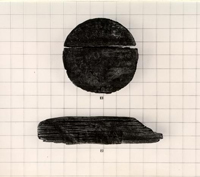 Plate XXVIII. Base of Wooden Paint Tub and Inscribed Fragment.
Plate XXVIII. Base of Wooden Paint Tub and Inscribed Fragment.
PLATE XXIX
- 1.Fragment of a Portland step (?) photographed from the underside, the upper face worked with a half round moulding at the fore-edge above a ½" square cut band, concave below. E.R.44A.
- 2.Coping brick, pale yellowish-pink body, chamferred at one side to within ¾" of the bottom. Chamferred face 2-½" in height, top 2-1/4" wide, back 2-¾" in height, bottom 4-¼" wide and 8-5/8" in length. E.R.44C6.
- 3.Part of a stove (?) brick, illustration shows concave face with fore-edge to left, a quarter-round moulding at the right edge (upper in photograph) was presumably repeated at the left. Coarse yellow body, grit tempered, unevenly pinked by heat. E.R.44B.
PLATE XXX
Fragment of heavy slate gravestone inscribed "...elation ... F]riend." E.R.44B. 18th century.
The Wood from the Wythe House South Well
E.R.44C7
1 thick tapering board end, 2-5/8" at greatest width, ¾" in thickness, possibly the end of a fence paling.
1 small decorative furniture fragment, a strip 1-¾" in width, 3/8" in thickness, curving outwards and narrowing at one end into a disc terminal.
1 fragment of garden chair with the name DIXON inscribed on one side and the initials A.M. on the others. See. Pl. XXVIII. No. 2.
E.R.44C7-10
18 small fragments representing trimmings from boards, posts, etc., none large enough to be identifiable.
E.R.44C8
A single jointed board, possibly from a small well head, nails through wings from above. Pl. XXXII. No. 1.
20 pieces of board of various widths, all tapering at one end - possibly debris from shingle-making, widths ranging from 4-4/8" to 7/8 Thickest fragment ½" at the butt.
1 piece-of board 3-3/8" in width, 5/8" in thickness and chamfered along one edge.
1 lid for a well (?) pitcher, cut to fit a spout, having a semi-circle trimmed out at the right side to allow the handle of a ladle to protrude; traces of central nail to hold knob for raising the lid. Length, rear to spout: 6-¼", width: 5-5/8", thickness: 1".
E.R.44C9
7 possible trimmings from shingles.
4 indeterminate trimmings.
9 staves and a group of fragments from a small paint tub. The base or top of this object is illustrated in P.. XXVIII. The
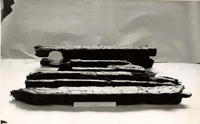 Plate XXXI. Shaped Timbers, Possibly from the Well-head.
56.
staves bound with willow.
Plate XXXI. Shaped Timbers, Possibly from the Well-head.
56.
staves bound with willow.
E.R.44C11-12
7 rectangular sectioned lengths of wood each cut at one end to lock into another timber and each roughly chopped at the other. It has been suggested that the objects were driven into the ground when in use and were subsequently cut down. No nail holes. Surviving length of specimen example: 15-¼", width: 4-¼", thickness at one side: 2-½", thickness at the other: 2", thickness above Joint 7/8 Depth of recess 1-¾", to 1-¼", height of recess: 6-7/8". See Pl. XXXII. No. 6.
1 bucket bottom (incomplete) diameter: 11-¼".
5 trimmings of various sizes.
E.R.44Cl3
15 trimmings of various sizes., 1 tapering fragment pierced by small nail.
1 chopped section of rough timber probably from the fork of a tree.
E.R.44Cl4
3 fragments from bucket bottoms, average diameter approximately: 11-½"
PLATE XXXI
A group of four large, shaped timbers which may have formed part of a windlass or well-head. For details see measured drawing Pl. XXXII. No. 2-5. These timbers had floated on the water surface and had helped to create the false bottom described on P. 37. E.R.44C7-9. See Section through well, Pl. XIV.
Footnotes
EXCAVATION OF WYTHE HOUSE SOUTH WELL AND DAIRY FOUNDATION
May-June 1958
Interim Report
As part of the research project to determine the original use of the Wythe House south outbuilding, it was suggested that the excavation of the associated well might reveal evidence of the building's purpose. The suggestion was approved and the excavation was carried out during the months of May and June, 1958.
The top of the well had previously been excavated during the full archaeological investigation of the site in 1938 and was reported on in the subsequent report (p. 8) as follows:
"A filled-in well 4 feet in diameter, between the South Outbuilding and the Dairy, was opened up to a depth of 9 feet. No evidences of a lining were discovered, nor any indication of the date of the well.* Its location offers some support to the assumption that the nearby remains may be those of a kitchen and a dairy.
The results of the 1958 excavations throw some new light on the foregoing statements. It is now considered unlikely that the well and the south outbuilding were in use contemporaneously, no evidence that the well was dug prior to c.1800. However, it is likely that the well and dairy were of the same date, i.e. c.1800-1815.
-2-The salient factors supporting these premises are as follows:
The South Well
At 13' below the present grade the top of the brick lining was encountered, the upper courses having been removed for re-use, probably during the decade 1860-70. A fill of mixed clay, dirt and trash extended from 8'6" 1. to 18' representing a deposit inserted after the upper well bricks had been robbed. The inclusion of two pieces of printers' type in this fill suggested that it had been brought from the site of the Printing Office (18H).
At 18' the sealing deposit gave way to an accumulation of refuse thrown into the well during the last days of its existence. This wet, organic stratum descended to a depth of 28' below modern grade and contained a large quantity of refuse deposited no earlier than 1853. The presence in the layer of medicine bottles, flasks and items of chemical glassware indicated that the artifacts came from the Wythe House during the occupancy of Professor John Millington who rented it in 1835, bought it in 1841 and sold it in 1866. It should be added that Millington was, for a time, Professor of Chemistry and Natural Sciences at the College of William and Mary and that in 1848 he had gone to the University of Mississippi in a similar capacity. Evidence of this move is indicated by the presence in the well of a small lead glazed pot of non-European manufacture, probably a souvenir brought back from the Professor's southern travels. It seems probable that the refuse may have been thrown into the well in 1866 when Millington sold the Wythe House.
At 28' four large timbers were found wedged in the shaft and it was these which had prevented the upper filling from sinking to the bottom. -3- When these timbers were removed the remainder of the filling which they supported sank into ten feet of water. It has been deduced that the timbers -possibly part of a simple well-head - collapsed into the well and floated on the surface of the water. Subsequently, Millington's trash was thrown down, some of it sinking past the timbers, but the majority piling up on them until a platform or false-bottom was established. Evidence of this is derived from the discovery of fragments of the same ceramic vessels, both above the platform and at the bottom of the well.
After a long delay caused by an inability to pump out the water, work was resumed and the remains of the collapsed upper layer was extracted. Beneath this, at approximately 38', was found a quantity of refuse which had fallen past the timbers when first thrown in. The finds included ox skulls, chemical glasswares and pieces of mid 19th century ceramics. A small number of coarse sherds, possibly dating from the 18th century, were also recovered, but as they overlay 19th century material they cannot be used in evidence.
The bottom of the brickwork was reached at 39'7", under which was 1 found a well-preserved wooden form, 3" in thickness,1 resting on natural blue marl.
The absence of any primary deposit of 18th century artifacts at the bottom of the well could indicate firstly, that the well had remained completely clean until it was abandoned, secondly, that it had been totally cleaned out during the course of its life or thirdly, that the well was of 19th century date. The first theory may be dismissed as highly improbable, but the second demands careful consideration. However, the realization that the water still flows into the well too fast for it to be emptied without the aid of mechanical pumps and that it is too deep even for these to function -4- properly, indicates that it would have been virtually impossible for 18th century well cleaners to have extracted anything but large items which would have been reached by a grapple. Small artifacts and the natural accumulation of organic silt could not have been extracted by this means. Providing that this "fact" can be accepted, there remains only the third explanation.1 The diameter of the well at the top surviving course was approximately 4' 7-½", but tapered to 3' 4" at the bottom. A number of well bricks were found in the fill above the timber platform, many of them with shell mortar attached. However, none of the bricks found in situ had been mortared, indicating that the upper courses only had been mortared and that in prying them loose, some had fallen into the well. One of the well bricks was retained and measures 8' x 4-3/8 x 3-¼" x 3", 37 of them making up the circumference of the well.
The South Dairy
The re-excavation of the S.W. corner of this foundation revealed a single course, 1 brick in thickness, unmortared. It was found that a lone well brick had been incorporated in this foundation, the brick, measuring 8" x 4-7/16" - 3-¼" x 3". The similarity of measurement and texture between this brick and the specimen from the well could indicate that they came from the same source. Furthermore, the absence of mortar on the well brick could suggest that it was left over after the digging of the well and that it was thereupon incorporated into the foundation of the dairy. If this were so, then it would automatically follow that the well must have been completed prior to 1815 when the dairy first appeared on an insurance plat. The dairy's absence from the plats of 1801 and 1806 indicates (though does not -5- prove) that it was not in existence prior to 1806 and 1815. The archaeological data recovered from the re-excavation of the dairy did not provide any conclusive dating, although some general pointers were provided.
- (1)It was found that the bed of marl previously recorded as being confined within the walls of the dairy actually extended beneath the foundation and beyond it both west and south. It might be suggested, therefore, that the foundation rested on the remains of an earlier marl path or yard. Artifacts found beneath the marl proved that it could not have been laid before the decade c.1770-80, and consequently, the dairy must date to the same time as the laying of the marl or, if the marl served some other purpose, to another date between c.1780 and 1815.
- (2)A hole was discovered, dug into dirty clay beneath the 1" marl stratum suggested that it had been cut to house the roots of a plant, thus pointing to the existence of a garden at this point prior to 1780. Finds from the fill of the hole indicated that it had been dug during the third quarter of the 18th century.
- (3)While no evidence for the destruction date of the dairy was found, a deposit of burnt clay and wood ash overlay the marl within the building. Such a deposit appears out of place in a building devoted to cooling rather than heating. It is, therefore, Just possible that this building (which does not appear in exactly the position shown on the insurance plat) may not have been the dairy, but a structure in which heat was used, built after 1815. If this were so, there would be no reason why the date of the well might not also be brought forward.
